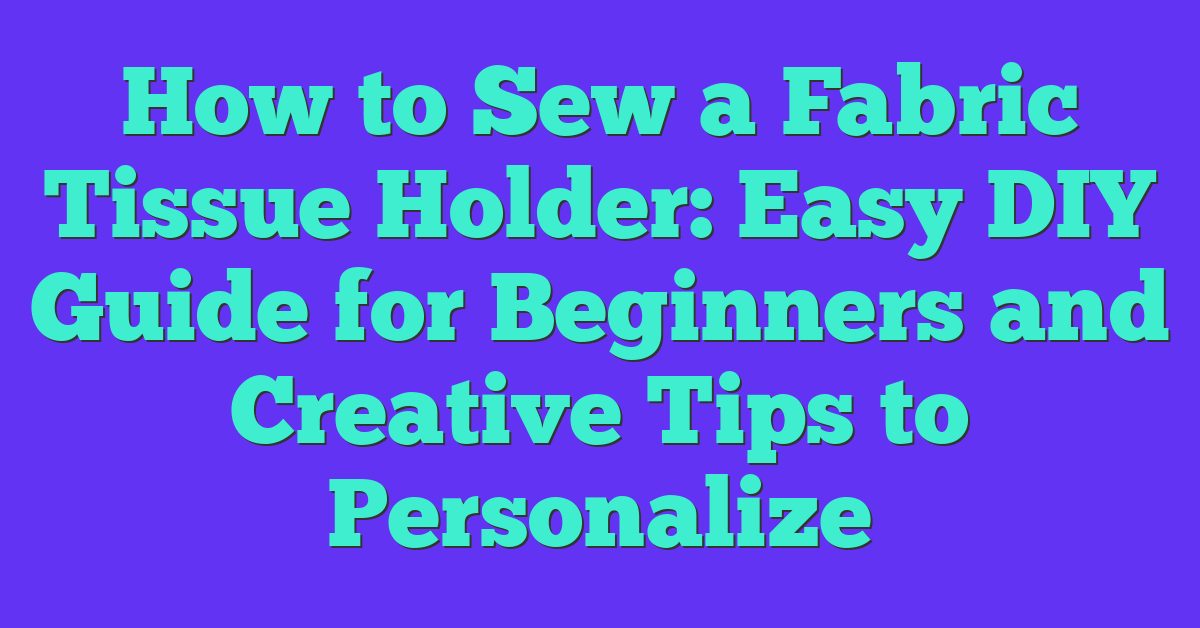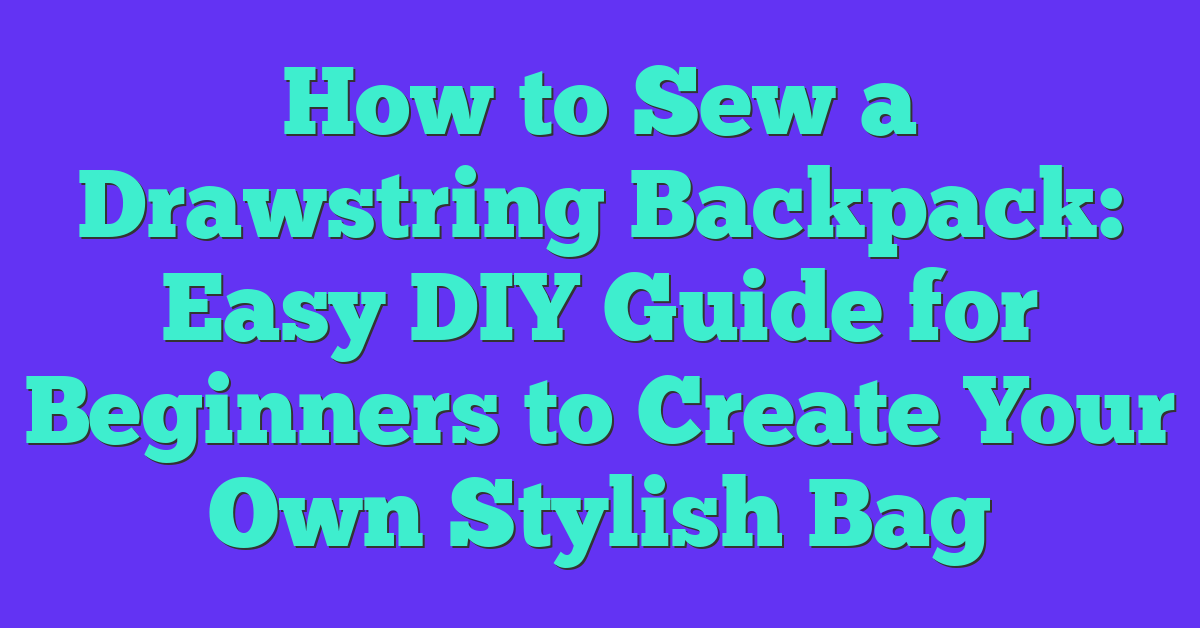I’ve always loved little DIY projects that are both fun to make and super practical, and sewing a fabric tissue holder checks all the boxes. It’s a quick project that doesn’t require a ton of fabric or fancy tools, making it perfect for beginners or anyone short on time. Plus, who doesn’t love having a cute, reusable way to keep tissues handy?
Materials Needed
Creating a fabric tissue holder only requires a few items. Here’s a list of materials I use for this project:
- Fabric: Two pieces of cotton fabric, each measuring 6.5 x 7.5 inches. One piece serves as the exterior, while the other acts as the lining. Choose complementary patterns or colors for an appealing design.
- Sewing Machine: A basic sewing machine works perfectly for straight stitches on light fabrics.
- Thread: All-purpose thread in a color that matches or contrasts your fabric, depending on your aesthetic preferences.
- Scissors or Rotary Cutter: Fabric scissors or a rotary cutter ensure clean, precise cuts.
- Measuring Tape or Ruler: Accurate measurements help achieve a neat finish.
- Pins or Clips: These secure the fabric layers together during sewing to prevent shifting.
- Iron: Pressing the fabric before and during sewing eliminates creases and achieves a professional look.
Having these materials ready streamlines the process and makes sewing the tissue holder enjoyable.
Preparing Your Fabric
Getting the fabric ready is essential for creating a well-finished tissue holder. Proper preparation ensures the final product is neat and lasts longer.
Choosing the Right Fabric
I start by selecting cotton fabric because it’s durable and easy to sew. A tightly woven cotton works best to maintain the structure of the tissue holder. For added creativity, I like to choose complementary prints, such as florals and polka dots, for the outer and lining fabric. Avoid stretchy or thick materials since they can complicate the sewing process. Pre-washing the fabric prevents shrinkage later.
Measuring and Cutting the Fabric
Precision is crucial when cutting fabric. I use a measuring tape or ruler to mark two rectangle pieces, each measuring 6 inches by 7 inches. For straight, clean edges, I cut the fabric with a rotary cutter on a cutting mat. If you don’t have a rotary cutter, sharp fabric scissors will work. Clipping small notches where folds or seams will go helps simplify sewing later. Neat, accurate cuts make assembling easier and improve the overall finish.
Sewing the Tissue Holder
With the fabric prepared, it’s time to bring the tissue holder to life. Follow these practical steps to assemble, stitch, and complete your project with finesse.
Assembling the Pieces
I align the two fabric pieces with their right sides facing each other. The right side is the side with the pattern or print you want visible. Ensuring the edges match perfectly, I secure the layers in place using pins or clips, especially along the shorter edges. If alignment shifts during sewing, it’s harder to maintain a crisp finish, so this step ensures accuracy.
Stitching the Edges
I start by stitching along each shorter edge, maintaining a 1/4-inch seam allowance for tidy, even results. Using a straight stitch, I sew with a steady speed to achieve smooth seams. Once both short edges are done, I turn the fabric so the outer side faces up and fold each stitched edge inward about 1 inch toward the center. The folded edges should meet but not overlap. Holding everything in place with pins, I then sew along both outer edges, reinforcing each end to prevent unraveling.
Adding Finishing Touches
After stitching, I trim away any loose threads for a clean look. I flip the fabric inside out carefully, making sure the right side is now visible and corners are crisp. Pressing the fabric gently with an iron smooths out wrinkles and enhances the shape of the tissue holder. I take a moment to ensure all seams are neatly aligned, giving it a polished, professional finish.
Tips for Personalizing Your Tissue Holder
Adding personal touches to a fabric tissue holder makes it unique and aligns it with your style. I often experiment with embellishments and fabric choices to achieve a custom look.
Embellishments and Decorations
Adding embellishments enhances the holder’s design. I like to sew buttons, delicate lace trims, or even small fabric bows to the edges for decoration. For a functional element, I sometimes attach a small loop of ribbon for hanging the holder. Hand embroidery is another favorite of mine—it adds a personalized touch. For example, I’ve stitched monograms or simple floral motifs onto plain fabric to make thoughtful gifts. Iron-on patches or fabric paint can also transform a simple design into something special, especially if you’re short on time or prefer a no-sew approach to decorating.
Creative Fabric Choices
Creative fabric choices help reflect personality or match the holder with a space. I enjoy mixing prints like florals with stripes or polka dots for contrast. Seasonal patterns, such as snowflakes for winter or floral patterns for spring, also make the holder align with the time of year. If you prefer subtle designs, minimalist patterns or solid colors in neutral tones provide a modern, clean look. I often upcycle scraps from other sewing projects like denim or linen, which adds variety and reduces waste. Using novelty fabrics with cartoon characters or playful prints is a fun choice for kids’ tissue holders.
Benefits of Sewing Your Own Tissue Holder
Sewing a fabric tissue holder combines practicality and creativity. It lets me create a functional item while showcasing my personal style through fabric and design choices. Using coordinated or embroidered fabrics turns a simple necessity into a decorative piece.

I save money by sewing my own instead of purchasing mass-produced options. This project only requires small fabric scraps and basic materials, making it cost-effective. Reusing leftover fabrics also minimizes waste, adding an environmentally friendly element to the craft.
Custom dimensions and designs ensure the tissue holder meets my needs. I can make one to fit travel-sized packs, loose tissues, or even unique shapes. Adding embellishments or themed fabrics makes it suitable for gifting or specific occasions.
Durability improves when I sew the tissue holder myself. Selecting high-quality materials and making secure seams ensures it lasts and handles frequent use. This handmade approach often leads to better results compared to lower-quality store-bought alternatives.
Finally, sewing this item is beginner-friendly and boosts my crafting skills. The simple steps build confidence for tackling more complex projects in the future. Plus, the fun of personalizing the holder makes the process enjoyable.
Conclusion
Sewing a fabric tissue holder is such a rewarding project that combines creativity with practicality. It’s amazing how a simple DIY can brighten up your day and add a personal touch to something so ordinary. Plus, it’s a fantastic way to use up fabric scraps and experiment with fun designs.
« Unlock Perfect Sewing with Basting Stitch Basics: When and How to Use It
Making a Fabric Napkin Ring Set: Creative Ideas to Elevate Your Table Décor Effortlessly »
Whether you’re crafting for yourself, as a gift, or just to unwind, this little project is a wonderful way to express your style. I hope you enjoy creating your own unique tissue holder and feel proud of the handmade charm it brings to your everyday life. Happy sewing!

















